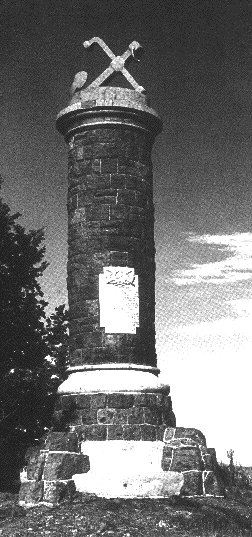A Scott memorial at Port Chalmers, NZ.
Episode: 25.
Site Number: 130.
Date Posted: 5 October 1996. Update 12 March 2000.
Location: Port Chalmers, New Zealand.
Type: Memorial.
 High on a hilltop above Port Chalmers, the port of Dunedin, New Zealand, is a large monument to Robert Scott. All I know of it comes from two photographs in the collections of the Scott Polar Research Institute. One--a small snapshot dated August 1916, not much more than four years after Scott's death--shows a harbor scene below and at the top of what appears to be a very steep hill, is a cylindrical column on a base, silhouetted against the sky. It looks very tall, 20 or 30 feet at least.
High on a hilltop above Port Chalmers, the port of Dunedin, New Zealand, is a large monument to Robert Scott. All I know of it comes from two photographs in the collections of the Scott Polar Research Institute. One--a small snapshot dated August 1916, not much more than four years after Scott's death--shows a harbor scene below and at the top of what appears to be a very steep hill, is a cylindrical column on a base, silhouetted against the sky. It looks very tall, 20 or 30 feet at least.
A second, larger photograph is a closer view of the monument with the sea below and distant land beyond. It's constructed of mortared dressed stone laid in a random pattern as a cylinder, set atop a molded stone base and capped with a similar molded top. In other words, it resembles a classical column. Above the top cap is an anchor, probably bronze, resting on its stock. Affixed to the lower portion of the column is what appears to be be a light colored stone or possibly bronze plaque with a decorative design on top and lettering that is far too distant to read. Any ideas as to the inscription?
Port Chalmers--described by Wilson as "...a very beautiful bit of coast scenery, very hilly..."--holds an important place in Antarctic exploration and certainly for Scott as it was his last southward port of call for both the Discovery and the Terra Nova.
Update 12 March 2000: Since posting this Episode an excellent book has appeared by Ian Church entitled Last Port to Antarctica. Dunedin and Port Chalmers: 100 Years of Polar Service (Dunedin: Otago Heritage Books, 1997). It sheds much light on the Scott memorial. This is what he says on pages 29 and 30:
Scott's death had a tremendous impact in Otago. The Otago branch of the Navy League issued an illustrated copy of his last words and several memorials were erected. The Port Chalmers Borough Council decided to construct a cairn on a hill overlooking the lower harbour, using stone quarried from the hillside below Lean's Rock and shaped by stonemason James Riach. As Scott had once belonged to the Masonic Lodge the foundation stone was laid with masonic ceremony by Brother T.S. Graham of the District Grand Lodge of Otago and Southland on 13 December 1913. Heavy rain restricted the attendance.
The circular cairn, 9m high with an anchor cast in concrete on the top, was unveiled on 30 May 1914 by the Prime Minister, the Rt Hon W.F. Massey, again in miserable conditions. The memorial includes Scott's last message:
I do not regret this journey which has shown us that Englishmen can endure hardships, help one another, and meet death with as great a fortitude as ever in the past. We took risks, we knew we took them. Things have come out against us, and therefore we have no cause for complaint, but bow to the will of providence, determined still to do our best to the last. Had we lived, I should have had a tale to tell of the hardihood, endurance and courage of my companions, which would have stirred the heart of every Englishman. We have been willing to give our lives to this enterprise.
At the foot is engraved the words: 'Your children shall ask their fathers in time to come, saying, "What mean these stones?" - Joshua IV, 21' -- a text suggested by Mrs Agnes Irvine, an early Scottish pioneer of the port.
Spreading across pages 30 and 31 is a stunning panoramic photograph taken at the unveiling of the monument on 30 May 1914.
[Last Port to Antarctica may be obtained from Otago Heritage Books, P. O. Box 6318, Dunedin, NZ. NZ$39.95. ISBN 0-908774-37-0.]
More on Port Chalmers' Antarctic connections may be found at
http://portc.bizland.com/antarc.htm
 High on a hilltop above Port Chalmers, the port of Dunedin, New Zealand, is a large monument to Robert Scott. All I know of it comes from two photographs in the collections of the Scott Polar Research Institute. One--a small snapshot dated August 1916, not much more than four years after Scott's death--shows a harbor scene below and at the top of what appears to be a very steep hill, is a cylindrical column on a base, silhouetted against the sky. It looks very tall, 20 or 30 feet at least.
High on a hilltop above Port Chalmers, the port of Dunedin, New Zealand, is a large monument to Robert Scott. All I know of it comes from two photographs in the collections of the Scott Polar Research Institute. One--a small snapshot dated August 1916, not much more than four years after Scott's death--shows a harbor scene below and at the top of what appears to be a very steep hill, is a cylindrical column on a base, silhouetted against the sky. It looks very tall, 20 or 30 feet at least.